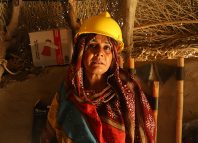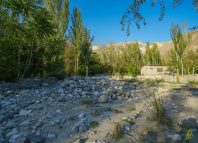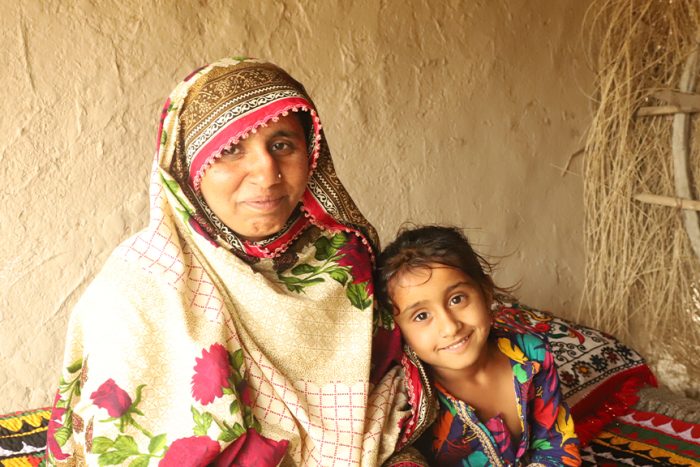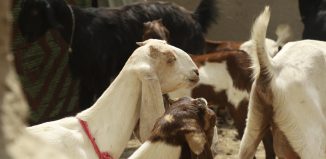Bringing Hope and Health Back to Flood-Affected Khairpur
Sawal and her husband Sikandar Ali, a driver, faced immense hardship when they lost their livestock and home during the torrential rains. For almost two months, the couple and their five-year-old daughter were forced to live in makeshift tents on higher grounds, on a sharing basis with other villagers. In June 2022, the rural areas of Sindh were severely impacted by heavy rains, devastating villages and leaving the residents in dire conditions. Subhan Panhyar village, located in Khairpur District, was among the hardest hit, with nearly everyone left without land and food.

The villagers had to ration food items among themselves for months, often finding it insufficient. There were days when the village elders went without food to ensure the younger children could eat. Sawal and her family endured this struggle for two months, compromising on food, shelter, and land. The rains took everyone’s possessions and destroyed the lands that provided a means of livelihood. In the villages of Khairpur, nearly every family worked in the fields and depended on agriculture, but the floods struck just as the land was ready for harvest. The rains ruined everything, leaving the villagers without crops to sell or consume, which severely worsened their situation.
Sawal, after having her daughter, tried to conceive another child many times, but nothing seemed to work. The long gap between having children was distressing for her family, who desperately desired a new family member. Sawal and Sikandar traveled from their small village to Ranipur in search of better clinics but their efforts were unsuccessful. Sikandar also took Sawal to a government hospital in Karachi, but they returned empty-handed.

“It used to cost us a lot,” Sawal said, “A trip to Sukkur would mean spending PKR 2000 (approx 7.2 USD) on commuting and another 1500 PKR (approx 5.4 USD) on prescribed medicines. When we went to Karachi, we ended up in extreme debt. I took a loan of PKR 20,000 (approx 72 USD) from my boss, where I work as a driver, but we had to return because we couldn’t afford the living expenses in a city like Karachi.” Despite their efforts and expenses, Sawal was still unable to conceive, leaving her devastated.
Community World Service Asia (CWSA) has been implementing flood response projects in flood affected districts of Sindh, including Khairpur. With the support of Disaster Emergency Committee (DEC) and CAFOD, CWSA launched a Flood Recovery Response that included the establishment of two Rural Health Clinics (RHC), the provision of two Mobile Health Units (MHU), and free medicines, awareness through medical camps and health sessions.
When a community mobiliser of CWSA held a health session in Subhan Panhyar, the villagers were informed about the visiting hours, location, and health facilities of the nearby Mobile Health Unit. Upon hearing this, Sawal wasted no time and decided to visit the clinic.
In January 2024, when Sawal visited the clinic for the first time, she was prescribed medications to improve her health, including calcium and vitamins. After just one month of consistent treatment, Sawal was able to conceive. “I could not believe it when the doctors gave me a strip test, and it came back positive,” Sawal said. “We had been trying for months with no success. It was the lady health workers and the medications from the health unit that made the difference. Previously, doctors had given me medications without explaining the problem. At the clinic, they told me my body was too weak to bear a child. Once my health improved, I conceived quickly.”

The medical staff guided her to maintain a healthy diet and lifestyle, ensuring both she and her baby received the necessary nutrients for a healthy pregnancy. Sawal is now three months pregnant. She has visited the clinic twice—once when she was upset about not being able to conceive, and the second time to inform the Lady Health Worker (LHW) and Lady Health Visitor (LHV) of her pregnancy. She continues to visit the clinic as needed, receiving medicines for her unborn child, herself, and occasionally for her daughter if she is unwell.
“We wasted so much money on city doctors and medicines. If only I had known earlier about this health clinic, we wouldn’t be in debt,” Sawal reflected. Currently, Sikandar owes his boss PKR 20,000, but Sawal is hopeful that they will repay it. With their desire for a new baby almost fulfilled, Sikandar is now free of stress and works day and night to earn more as their family will soon be expanding.
Since the project’s implementation in March 2023, a total of 40,556 patients have visited the Rural Health Clinics (RHCs) for the first time, and 48,945 patients have visited the MHUs for general OPD. At the RHCs in Nara Gate and Choondko, primary health care services are provided, including General OPD, Antenatal Care (ANC), Prenatal Care (PNC), and normal baby deliveries. Each day, the dedicated CWSA staff at these RHCs and Mobile Health Units (MHUs) accommodate up to 120 patients at each location, ensuring that vital healthcare services reach those in need.







